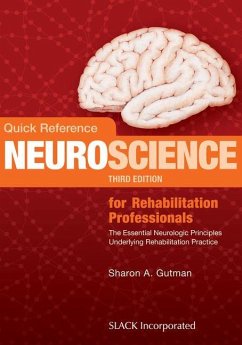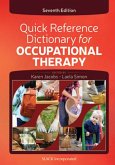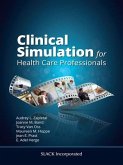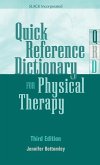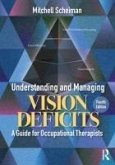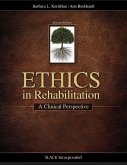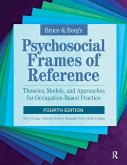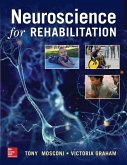Sharon A Gutman
Quick Reference Neuroscience for Rehabilitation Professionals
The Essential Neurologic Principles Underlying Rehabilitation Practice
Schade – dieser Artikel ist leider ausverkauft. Sobald wir wissen, ob und wann der Artikel wieder verfügbar ist, informieren wir Sie an dieser Stelle.
Sharon A Gutman
Quick Reference Neuroscience for Rehabilitation Professionals
The Essential Neurologic Principles Underlying Rehabilitation Practice
- Broschiertes Buch
- Merkliste
- Auf die Merkliste
- Bewerten Bewerten
- Teilen
- Produkt teilen
- Produkterinnerung
- Produkterinnerung
"Quick Reference NeuroScience for Rehabilitation Professionals: The Essential Neurologic Principles Underlying Rehabilitation Practice, Third Edition" is a user-friendly, comprehensive text that specifically addresses the key information needed to understand the neuroscience of clinical rehabilitation.
Andere Kunden interessierten sich auch für
![Quick Reference Dictionary for Occupational Therapy Quick Reference Dictionary for Occupational Therapy]() Karen JacobsQuick Reference Dictionary for Occupational Therapy120,99 €
Karen JacobsQuick Reference Dictionary for Occupational Therapy120,99 €![Clinical Simulation for Healthcare Professionals Clinical Simulation for Healthcare Professionals]() Clinical Simulation for Healthcare Professionals89,99 €
Clinical Simulation for Healthcare Professionals89,99 €![Quick Reference Dictionary for Physical Therapy Quick Reference Dictionary for Physical Therapy]() Jennifer BottomleyQuick Reference Dictionary for Physical Therapy59,99 €
Jennifer BottomleyQuick Reference Dictionary for Physical Therapy59,99 €![Understanding and Managing Vision Deficits Understanding and Managing Vision Deficits]() Mitchell ScheimanUnderstanding and Managing Vision Deficits53,99 €
Mitchell ScheimanUnderstanding and Managing Vision Deficits53,99 €![Ethics in Rehabilitation Ethics in Rehabilitation]() Barbara KornblauEthics in Rehabilitation95,99 €
Barbara KornblauEthics in Rehabilitation95,99 €![Bruce & Borg's Psychosocial Frames of Reference Bruce & Borg's Psychosocial Frames of Reference]() Terry KrupaBruce & Borg's Psychosocial Frames of Reference117,99 €
Terry KrupaBruce & Borg's Psychosocial Frames of Reference117,99 €![Neuroscience for Rehabilitation Neuroscience for Rehabilitation]() Tony MosconiNeuroscience for Rehabilitation111,99 €
Tony MosconiNeuroscience for Rehabilitation111,99 €-
-
"Quick Reference NeuroScience for Rehabilitation Professionals: The Essential Neurologic Principles Underlying Rehabilitation Practice, Third Edition" is a user-friendly, comprehensive text that specifically addresses the key information needed to understand the neuroscience of clinical rehabilitation.
Produktdetails
- Produktdetails
- Verlag: Taylor & Francis
- 3rd edition
- Seitenzahl: 446
- Erscheinungstermin: 15. September 2016
- Englisch
- Abmessung: 280mm x 216mm x 24mm
- Gewicht: 1119g
- ISBN-13: 9781630911522
- ISBN-10: 1630911526
- Artikelnr.: 47223808
- Herstellerkennzeichnung
- Libri GmbH
- Europaallee 1
- 36244 Bad Hersfeld
- gpsr@libri.de
- Verlag: Taylor & Francis
- 3rd edition
- Seitenzahl: 446
- Erscheinungstermin: 15. September 2016
- Englisch
- Abmessung: 280mm x 216mm x 24mm
- Gewicht: 1119g
- ISBN-13: 9781630911522
- ISBN-10: 1630911526
- Artikelnr.: 47223808
- Herstellerkennzeichnung
- Libri GmbH
- Europaallee 1
- 36244 Bad Hersfeld
- gpsr@libri.de
Sharon A. Gutman, PhD, OTR, FAOTA is an Associate Professor of Rehabilitation and Regenerative Medicine in the Occupational Therapy Programs at Columbia University in New York, New York. Dr. Gutman has a background in neuroscience and has worked with a wide array of populations as an occupational therapist, including traumatic brain injury, psychiatric disability, autism spectrum disorder, developmental delay, and homelessness. In the past 2 decades, she has taught courses and written journal articles and books regarding the fundamentals of clinical neuroscience and the neurologic basis of pathological conditions. Dr. Gutman served as the editor of the American Journal of Occupational Therapy between 2008 and 2014.
About the Author Foreword by Ashwini K. Rao, EdD, OTR, FAOTAIntroduction
Section 1 Directional Terminology Section 2 Division of the Nervous System
Section 3 Gross Cerebral Structures Section 4 Ventricular System Section 5
The Cranium Section 6 The Meninges Section 7 Spinal Cord Anatomy Section 8
The Cranial Nerves Section 9 Sensory Receptors Section 10 Neurons and
Action Potentials Section 11 Special Sense Receptors Section 12 Vestibular
System Section 13 Autonomic Nervous System Section 14 Enteric Nervous
System Section 15 Pain Section 16 Peripheral Nerve Injury and Regeneration
Section 17 Phantom Limb Phenomenon Section 18 Spinal Cord Tracts Section 19
Spinal Cord Injury and Disease Section 20 Proprioception Section 21
Disorders of Muscle Tone Section 22 Motor Functions and Dysfunctions of the
Central Nervous System: Cortex, Basal Ganglia, Cerebellum Section 23
Sensory Functions and Dysfunctions of the Central Nervous System Section 24
Thalamus and Brainstem Sensory and Motor Roles: Function and Dysfunction
Section 25 Right vs Left Brain Functions and Disorders Section 26
Perceptual Functions and Dysfunctions of the Central Nervous System Section
27 Blood Supply of the Brain: Cerebrovascular Disorders Section 28 Commonly
Used Neurodiagnostic Tests Section 29 Neurotransmitters: The Neurochemical
Basis of Human Behavior Section 30 The Neurologic Substrates of Addiction
Section 31 Neurologic Mechanisms of Memory Section 32 The Neurologic
Substrates of Emotion Section 33 The Aging Brain Section 34 Sex Differences
in Male and Female BrainsGlossary Index
Section 1 Directional Terminology Section 2 Division of the Nervous System
Section 3 Gross Cerebral Structures Section 4 Ventricular System Section 5
The Cranium Section 6 The Meninges Section 7 Spinal Cord Anatomy Section 8
The Cranial Nerves Section 9 Sensory Receptors Section 10 Neurons and
Action Potentials Section 11 Special Sense Receptors Section 12 Vestibular
System Section 13 Autonomic Nervous System Section 14 Enteric Nervous
System Section 15 Pain Section 16 Peripheral Nerve Injury and Regeneration
Section 17 Phantom Limb Phenomenon Section 18 Spinal Cord Tracts Section 19
Spinal Cord Injury and Disease Section 20 Proprioception Section 21
Disorders of Muscle Tone Section 22 Motor Functions and Dysfunctions of the
Central Nervous System: Cortex, Basal Ganglia, Cerebellum Section 23
Sensory Functions and Dysfunctions of the Central Nervous System Section 24
Thalamus and Brainstem Sensory and Motor Roles: Function and Dysfunction
Section 25 Right vs Left Brain Functions and Disorders Section 26
Perceptual Functions and Dysfunctions of the Central Nervous System Section
27 Blood Supply of the Brain: Cerebrovascular Disorders Section 28 Commonly
Used Neurodiagnostic Tests Section 29 Neurotransmitters: The Neurochemical
Basis of Human Behavior Section 30 The Neurologic Substrates of Addiction
Section 31 Neurologic Mechanisms of Memory Section 32 The Neurologic
Substrates of Emotion Section 33 The Aging Brain Section 34 Sex Differences
in Male and Female BrainsGlossary Index
About the Author Foreword by Ashwini K. Rao, EdD, OTR, FAOTAIntroduction
Section 1 Directional Terminology Section 2 Division of the Nervous System
Section 3 Gross Cerebral Structures Section 4 Ventricular System Section 5
The Cranium Section 6 The Meninges Section 7 Spinal Cord Anatomy Section 8
The Cranial Nerves Section 9 Sensory Receptors Section 10 Neurons and
Action Potentials Section 11 Special Sense Receptors Section 12 Vestibular
System Section 13 Autonomic Nervous System Section 14 Enteric Nervous
System Section 15 Pain Section 16 Peripheral Nerve Injury and Regeneration
Section 17 Phantom Limb Phenomenon Section 18 Spinal Cord Tracts Section 19
Spinal Cord Injury and Disease Section 20 Proprioception Section 21
Disorders of Muscle Tone Section 22 Motor Functions and Dysfunctions of the
Central Nervous System: Cortex, Basal Ganglia, Cerebellum Section 23
Sensory Functions and Dysfunctions of the Central Nervous System Section 24
Thalamus and Brainstem Sensory and Motor Roles: Function and Dysfunction
Section 25 Right vs Left Brain Functions and Disorders Section 26
Perceptual Functions and Dysfunctions of the Central Nervous System Section
27 Blood Supply of the Brain: Cerebrovascular Disorders Section 28 Commonly
Used Neurodiagnostic Tests Section 29 Neurotransmitters: The Neurochemical
Basis of Human Behavior Section 30 The Neurologic Substrates of Addiction
Section 31 Neurologic Mechanisms of Memory Section 32 The Neurologic
Substrates of Emotion Section 33 The Aging Brain Section 34 Sex Differences
in Male and Female BrainsGlossary Index
Section 1 Directional Terminology Section 2 Division of the Nervous System
Section 3 Gross Cerebral Structures Section 4 Ventricular System Section 5
The Cranium Section 6 The Meninges Section 7 Spinal Cord Anatomy Section 8
The Cranial Nerves Section 9 Sensory Receptors Section 10 Neurons and
Action Potentials Section 11 Special Sense Receptors Section 12 Vestibular
System Section 13 Autonomic Nervous System Section 14 Enteric Nervous
System Section 15 Pain Section 16 Peripheral Nerve Injury and Regeneration
Section 17 Phantom Limb Phenomenon Section 18 Spinal Cord Tracts Section 19
Spinal Cord Injury and Disease Section 20 Proprioception Section 21
Disorders of Muscle Tone Section 22 Motor Functions and Dysfunctions of the
Central Nervous System: Cortex, Basal Ganglia, Cerebellum Section 23
Sensory Functions and Dysfunctions of the Central Nervous System Section 24
Thalamus and Brainstem Sensory and Motor Roles: Function and Dysfunction
Section 25 Right vs Left Brain Functions and Disorders Section 26
Perceptual Functions and Dysfunctions of the Central Nervous System Section
27 Blood Supply of the Brain: Cerebrovascular Disorders Section 28 Commonly
Used Neurodiagnostic Tests Section 29 Neurotransmitters: The Neurochemical
Basis of Human Behavior Section 30 The Neurologic Substrates of Addiction
Section 31 Neurologic Mechanisms of Memory Section 32 The Neurologic
Substrates of Emotion Section 33 The Aging Brain Section 34 Sex Differences
in Male and Female BrainsGlossary Index

